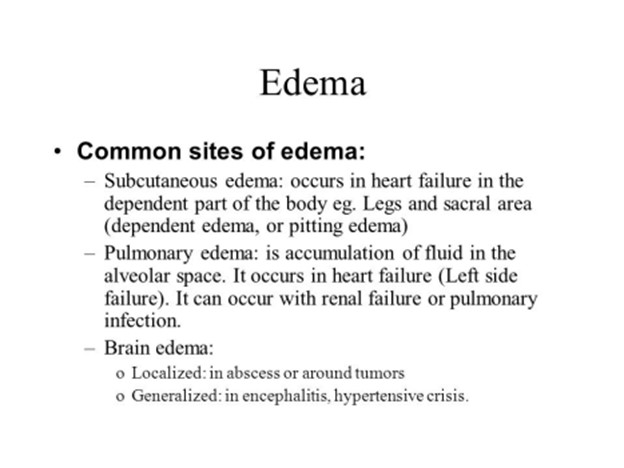The patient who is confined to bed in the supine position has gained 5 lbs. in the last 48 hours. In which area does the nurse assess skin turgor for accurate determination of dependent edema?
Foot
Forehead
Ankle
Chest
Sacrum
The Correct Answer is E
Dependent edema refers to the accumulation of fluid in the dependent parts of the body, which are areas that are most affected by gravity when a person is in a supine or sitting position for an extended period. The sacrum, which is the triangular bone at the base of the spine, is one such dependent area. It is prone to developing edema when there is increased fluid retention in the body, as seen in the patient's weight gain.
To assess for dependent edema accurately, the nurse can gently press the skin over the sacral area with their fingers and observe the skin turgor or the return of the skin to its normal position after releasing the pressure. If there is edema, the skin may have reduced elasticity and take longer to return to its normal position (poor skin turgor).
While edema can occur in other dependent areas such as the feet, ankles, and lower legs, assessing skin turgor in these areas may not provide an accurate determination of dependent edema as they are located further away from the sacrum and may be influenced by other factors.

Nursing Test Bank
Naxlex Comprehensive Predictor Exams
Related Questions
Correct Answer is ["A","B","D","E","F","G","H","J"]
Explanation
● Weight 98 lbs: This information helps determine the patient's baseline weight and assess for potential weight loss associated with dehydration.
● Dehydrated: The diagnosis of dehydration indicates a critical condition that requires immediate attention and intervention.
● Lethargy: Lethargy suggests a decreased level of consciousness and could indicate a severe state of dehydration or other underlying issues that need to be addressed promptly.
● HR 122: A heart rate of 122 beats per minute is elevated and may indicate compensatory mechanisms in response to dehydration or other underlying conditions. It requires further evaluation and intervention.
● Shortness of Breath: This symptom suggests respiratory distress and may be related to the patient's dehydration or underlying conditions. It requires immediate assessment and intervention.
● Temperature 100: An elevated temperature may indicate an underlying infection or inflammatory response. It requires further evaluation to determine the cause and guide appropriate treatment.
● Thirsty: The patient's report of feeling thirsty is an important symptom indicating dehydration and the need for fluid replacement.
● BP 90/50: A blood pressure of 90/50 is low and may be indicative of hypotension, which can occur in dehydration. It requires close monitoring and intervention to stabilize the patient's blood pressure.
The following items are not immediate concerns based on the given information: ● Admitted to the ER: While it is important information, it is not a current concern as the patient is already in the ER.
● Female: The patient's gender is not an immediate concern for the assessment and management of dehydration.
Correct Answer is B
Explanation
An increased serum potassium level, also known as hyperkalemia, can have adverse effects on the electrical conduction of the heart, potentially leading to life-threatening cardiac dysrhythmias. Therefore, it is crucial to assess the patient's pulse rate and rhythm promptly to identify any abnormal cardiac activity.
Assessing the oxygen saturation (oxygen stats), respiratory rate and depth, and deep tendon reflexes are also important assessments, but they are not the priority in this case. Hyperkalemia primarily affects cardiac function, and prompt identification of any potential cardiac rhythm disturbances is essential to prevent further harm.
Whether you are a student looking to ace your exams or a practicing nurse seeking to enhance your expertise , our nursing education contents will empower you with the confidence and competence to make a difference in the lives of patients and become a respected leader in the healthcare field.
Visit Naxlex, invest in your future and unlock endless possibilities with our unparalleled nursing education contents today
Report Wrong Answer on the Current Question
Do you disagree with the answer? If yes, what is your expected answer? Explain.
Kindly be descriptive with the issue you are facing.
